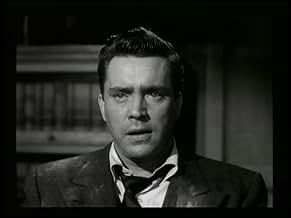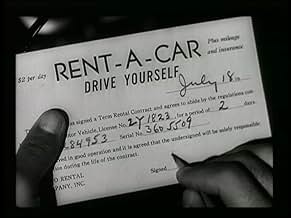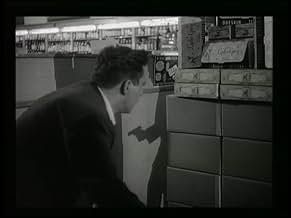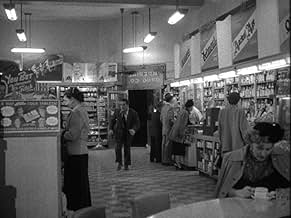Frank Bigelow, told he's been poisoned and has only a few days to live, tries to find out who killed him and why.Frank Bigelow, told he's been poisoned and has only a few days to live, tries to find out who killed him and why.Frank Bigelow, told he's been poisoned and has only a few days to live, tries to find out who killed him and why.
- Awards
- 2 wins total
Beverly Garland
- Miss Foster
- (as Beverly Campbell)
Cay Forester
- Sue
- (as Cay Forrester)
Frank Jaquet
- Dr. Matson
- (as Fred Jaquet)
Lawrence Dobkin
- Dr. Schaefer
- (as Larry Dobkin)
Bill Baldwin
- St. Francis Hotel Desk Clerk
- (uncredited)
Featured reviews
When I started watching all the film noirs I could find, I was a bit disappointed in this. However, after three viewings I now find it decent. It's nothing super, but certainly better than what I though at first. A big help is having a better print of the film. This is one of those movies that always had a poor VHS quality transfer and many times the same on DVD. Finding a good print is hard, although I finally got a decent one with this Killer Classic DVD set that includes this movie.
The story, like the print, is not always easy to follow, either, even though the premise is very simple. A man discovers he has been poisoned and there is no hope for recovery. Before he dies, he retraces his steps to find out who "murdered him" (even though he's still alive when saying that) and why.
The story gets a bit complicated. Like a Sherlock Holmes or Charlie Chan mystery, there are a number of suspects that keep popping up. Many of them are hard to figure.
This is an odd film noir for several quirky things in this movie. The lead character, "Frank Bigelow" (Edmund O'Brien), is strange and kind of stupid in the beginning. There are a half dozen of these dumb whistle-like wolf call sound-effects that come out every time he sees a pretty woman. It just doesn't fit in a tough film noir. Then there is his possessive girlfriend/secretary "Paula," (Pamela Britton) who is constantly calling him and paranoid about his whereabouts. She acts more like an insecure, nagging wife but she obviously cares a great deal about him. But, man, give the poor guy some space!
The dialog in this film ranges from incredibly stupid to very clever and solid film noir material.
We also see one of the most sadistic people I have ever seen on film: "Chester," played by the sadistic-looking Neville Brand. Wow, is this guy sick or what? He reminded me of "Vera" (Ann Savage) in "Detour." Those two would have made an interesting couple! Brand's character is only interested in one thing in life: inflicting pain and the slower and more brutal, the better.
Anyway, if you find a good print, tolerate some of the goofy things in the film, this is an interesting film noir that gets better with each viewing, as you understand the story better.
The story, like the print, is not always easy to follow, either, even though the premise is very simple. A man discovers he has been poisoned and there is no hope for recovery. Before he dies, he retraces his steps to find out who "murdered him" (even though he's still alive when saying that) and why.
The story gets a bit complicated. Like a Sherlock Holmes or Charlie Chan mystery, there are a number of suspects that keep popping up. Many of them are hard to figure.
This is an odd film noir for several quirky things in this movie. The lead character, "Frank Bigelow" (Edmund O'Brien), is strange and kind of stupid in the beginning. There are a half dozen of these dumb whistle-like wolf call sound-effects that come out every time he sees a pretty woman. It just doesn't fit in a tough film noir. Then there is his possessive girlfriend/secretary "Paula," (Pamela Britton) who is constantly calling him and paranoid about his whereabouts. She acts more like an insecure, nagging wife but she obviously cares a great deal about him. But, man, give the poor guy some space!
The dialog in this film ranges from incredibly stupid to very clever and solid film noir material.
We also see one of the most sadistic people I have ever seen on film: "Chester," played by the sadistic-looking Neville Brand. Wow, is this guy sick or what? He reminded me of "Vera" (Ann Savage) in "Detour." Those two would have made an interesting couple! Brand's character is only interested in one thing in life: inflicting pain and the slower and more brutal, the better.
Anyway, if you find a good print, tolerate some of the goofy things in the film, this is an interesting film noir that gets better with each viewing, as you understand the story better.
Great B-movie film noir, played as if his life depended on it (and it does) by Edmond O'Brien as a small-town notary who pays a big price for signing the wrong document at the wrong time, turning what should have been a pleasure trip to the west coast into a murderous affair altogether.
It starts with a bang, O'Brien staggering into the local homicide unit to tell the cops that there's been a murder - his, before launching into the massive flash-back which takes up pretty much the rest of the movie. The action from there on is hectic and as convoluted as all the best noirs are as O'Brien, infected by a deadly poison, races against the clock to track down his own killer and the reason behind it.
The film makes fine use of actual San Francisco and Los Angeles locations as well as authentically depicting the hot and steamy atmosphere at a Frisco jazz club. O'Brien is great as the doomed Bigelow, racing, often literally, against the clock, stopping only to palm off his adoring secretary girl-friend, Pamela Britten, who of course doesn't find out what's wrong with him until too late.
The pacing is almost non-stop once it gathers momentum, unfortunately when it does, some of the scene-writing gets over-ripe and correspondingly over-acted as O'Brien and his girl pour out their hearts somewhat unnecessarily. The film ends bravely though with a downbeat conclusion, delivering what the title says it must and at least tying up all the loose ends by that time.
It starts with a bang, O'Brien staggering into the local homicide unit to tell the cops that there's been a murder - his, before launching into the massive flash-back which takes up pretty much the rest of the movie. The action from there on is hectic and as convoluted as all the best noirs are as O'Brien, infected by a deadly poison, races against the clock to track down his own killer and the reason behind it.
The film makes fine use of actual San Francisco and Los Angeles locations as well as authentically depicting the hot and steamy atmosphere at a Frisco jazz club. O'Brien is great as the doomed Bigelow, racing, often literally, against the clock, stopping only to palm off his adoring secretary girl-friend, Pamela Britten, who of course doesn't find out what's wrong with him until too late.
The pacing is almost non-stop once it gathers momentum, unfortunately when it does, some of the scene-writing gets over-ripe and correspondingly over-acted as O'Brien and his girl pour out their hearts somewhat unnecessarily. The film ends bravely though with a downbeat conclusion, delivering what the title says it must and at least tying up all the loose ends by that time.
D. O. A. is an intriguing, fast paced movie, rife with metaphor. A mood of chaos and uncertain boundaries is introduced early in the film. At a hotel in San Francisco, businessman Frank Bigelow, seeking little more than the ephemeral pleasure of a brief trip, finds himself in the midst of party revelers. With unsettling frivolity, they roam randomly about their various guest rooms which appear unlocked and opened. The mood of strident, forced conviviality climaxes when they move the party to a local bar called "The Fisherman." As the jazz played in the venue intensifies in volume and rhythm, uneven camera angles catch the various musicians playing to the point that they're breaking sweat and literally, physically vibrating. Bigelow himself is jostled about in the crowd, actually losing his footing for a moment. The setting is that of a little world both frenzied and crazed. Bigelow appears detached as all react excitedly and emotionally to music that he admits isn't his taste.
This memorable key scene portends his disconnection from those around him and represents a crack, however slight, in his life's foundation. Though initially reticent about socializing and imbibing with people he just met, he has unwittingly been thrust into a reality more threatening than is immediately apparent. Later in the film, a jarring example of his full blown isolation occurs when he finds himself in an outdoor, public area. In unbearable turmoil, he momentarily encounters a little girl innocently playing with a toy. She appears in soft lighting, contrasting starkly to the shadows surrounding Bigelow, whose face registers the painful shock of awareness that ordinary activity continues unabated even while he grapples with extreme danger. This is reinforced when seconds later he observes a young couple embracing, compounding his agonizing realization that all simple pleasures are now unattainable to him. Noticeably, when he is literally "up against the wall" his back is touching signage of "Life Magazine" logos. All that once comprised his own life, that which he had considered to be little more than mundane minutiae, is heightened in significance and irrevocably at stake.
This memorable key scene portends his disconnection from those around him and represents a crack, however slight, in his life's foundation. Though initially reticent about socializing and imbibing with people he just met, he has unwittingly been thrust into a reality more threatening than is immediately apparent. Later in the film, a jarring example of his full blown isolation occurs when he finds himself in an outdoor, public area. In unbearable turmoil, he momentarily encounters a little girl innocently playing with a toy. She appears in soft lighting, contrasting starkly to the shadows surrounding Bigelow, whose face registers the painful shock of awareness that ordinary activity continues unabated even while he grapples with extreme danger. This is reinforced when seconds later he observes a young couple embracing, compounding his agonizing realization that all simple pleasures are now unattainable to him. Noticeably, when he is literally "up against the wall" his back is touching signage of "Life Magazine" logos. All that once comprised his own life, that which he had considered to be little more than mundane minutiae, is heightened in significance and irrevocably at stake.
**SPOILERS** Staggering into a L.A police station barely alive Frank Bigelow, Edmound O'Brien, has a story to tell about a murder that he witnessed, his own! It all happened two days ago when Bigelow was straying in San Francisco on vacation from his job as a tax accountant during Market Week. At the Fisherman Club Bigelow got a bit juiced up and during drinks he was slipped a dose of luminous toxin in his glass. It's that toxin that's now on the verge of killing him. The reason that he was poisoned had to do with him notarizing a bill of sale for a shipment of iridium that was stolen and could put the person who shipped it behind bars for at least five years!
It took a while for Bigelow to realize that he had a fatal dose of luminous toxin in his system and by the time he did it was too late to save his life. But it wasn't too late for Bigelow to track down and find the person or persons who had him poisoned. And it's during the rest of the movie, in flashback, that's exactly what he did! And did it with an unrelenting fury as if his life depended on it!
In what is undoubtedly Edmound O'Brien's best role as Frank "Biggie" Bigeow the film "D.O.A" has him move heaven and earth to find the person who eventually murdered him. From San Francisco to Los Angeles as well as parts in between Bigelow finally track him down to the Philips Inport-Export office at the Bradbury Building in downtown L.A. It in fact was Philips who was murdered, by being thrown to his death, because of the illegal iridium shipment that he later realized he was tricked into handling. With Philips dead the only person who could connect both his murderer and the person whom he shipped the iridium for is Frank Bigelow who handled, by notarizing the bill of sale, the shipment!
Non stop action thriller as a dying, or murdered, man turns L.A upside down in trying to find his killer and exact punishment on him before he himself expires! Bigelow also gets involved with L.A mobster Majak, Luther Adler, whom the illegal iridium was delivered for. In knowing about Majak's involvement in it had Bigelow targeted by him and his sadistic and unstable hit man Chester, Naville Brand, for immediate termination. That's if the luminous toxin doesn't kill him first!
Even though the movie is a scant 83 minutes long it packs enough action to fill some half dozen films of it's type: Film Noir Thrillers. Frank Bigelow is a man who knows that he hasn't long to live and therefore throws caution to the wind in trying to find his killer before the curtain comes down on him. It was in fact that almost suicidal determination on Bigelow's part that in the end brought him results!
It took a while for Bigelow to realize that he had a fatal dose of luminous toxin in his system and by the time he did it was too late to save his life. But it wasn't too late for Bigelow to track down and find the person or persons who had him poisoned. And it's during the rest of the movie, in flashback, that's exactly what he did! And did it with an unrelenting fury as if his life depended on it!
In what is undoubtedly Edmound O'Brien's best role as Frank "Biggie" Bigeow the film "D.O.A" has him move heaven and earth to find the person who eventually murdered him. From San Francisco to Los Angeles as well as parts in between Bigelow finally track him down to the Philips Inport-Export office at the Bradbury Building in downtown L.A. It in fact was Philips who was murdered, by being thrown to his death, because of the illegal iridium shipment that he later realized he was tricked into handling. With Philips dead the only person who could connect both his murderer and the person whom he shipped the iridium for is Frank Bigelow who handled, by notarizing the bill of sale, the shipment!
Non stop action thriller as a dying, or murdered, man turns L.A upside down in trying to find his killer and exact punishment on him before he himself expires! Bigelow also gets involved with L.A mobster Majak, Luther Adler, whom the illegal iridium was delivered for. In knowing about Majak's involvement in it had Bigelow targeted by him and his sadistic and unstable hit man Chester, Naville Brand, for immediate termination. That's if the luminous toxin doesn't kill him first!
Even though the movie is a scant 83 minutes long it packs enough action to fill some half dozen films of it's type: Film Noir Thrillers. Frank Bigelow is a man who knows that he hasn't long to live and therefore throws caution to the wind in trying to find his killer before the curtain comes down on him. It was in fact that almost suicidal determination on Bigelow's part that in the end brought him results!
Fans of film noir should see this one, as this film is up there with the best.
It's a story about how a simple act can lead to disaster in this case, death. If you've not seen it, I'm not about to tell you much except this: it has perhaps the most imaginative beginning for any murder mystery ever devised as Frank Bigelow (Edmond O'Brien) fronts up to the Homicide Bureau in Los Angeles to report a murder his own! Thereafter, the story traces Frank's attempts to find out who is trying to kill him, and why. One of the best pieces of irony is when, having learnt that he will die soon, Frank runs and runs until he's out of breath and stops, panting, beside a newsstand where there are multiple copies of Life magazine hanging there, just beside him. The director, Rudolph Mate, had a real insider joke with that shot.
And that long tracking shot, by the way, was an excellent example of how to use fast camera work and great editing.
On another level, the movie very much fits the times vis-à-vis the portrayal of evil and where it leads: retribution is always just around the corner for those who transgress society, even if you think you're justified. When you see this movie, you'll know what I mean.
And, for the times, the acting was good, with a standout performance from Edmond O'Brien, and ably supported by the ever-competent Luther Adler (as Majak, the sharp dealer in stolen goods), and Neville Brand, as the psychopathic Chester. The rest of the cast was adequate. The only jarring note (no pun intended) are the peculiar and bizarre wolf-whistles (inserted by some demented sound engineer?) that accompany Frank Bigelow as he looks at women in his hotel at San Francisco. What was the director thinking of...?
That aside, it's a good, fast-paced action mystery that helped to keep the film noir genre very much alive. Have a go...
It's a story about how a simple act can lead to disaster in this case, death. If you've not seen it, I'm not about to tell you much except this: it has perhaps the most imaginative beginning for any murder mystery ever devised as Frank Bigelow (Edmond O'Brien) fronts up to the Homicide Bureau in Los Angeles to report a murder his own! Thereafter, the story traces Frank's attempts to find out who is trying to kill him, and why. One of the best pieces of irony is when, having learnt that he will die soon, Frank runs and runs until he's out of breath and stops, panting, beside a newsstand where there are multiple copies of Life magazine hanging there, just beside him. The director, Rudolph Mate, had a real insider joke with that shot.
And that long tracking shot, by the way, was an excellent example of how to use fast camera work and great editing.
On another level, the movie very much fits the times vis-à-vis the portrayal of evil and where it leads: retribution is always just around the corner for those who transgress society, even if you think you're justified. When you see this movie, you'll know what I mean.
And, for the times, the acting was good, with a standout performance from Edmond O'Brien, and ably supported by the ever-competent Luther Adler (as Majak, the sharp dealer in stolen goods), and Neville Brand, as the psychopathic Chester. The rest of the cast was adequate. The only jarring note (no pun intended) are the peculiar and bizarre wolf-whistles (inserted by some demented sound engineer?) that accompany Frank Bigelow as he looks at women in his hotel at San Francisco. What was the director thinking of...?
That aside, it's a good, fast-paced action mystery that helped to keep the film noir genre very much alive. Have a go...
Did you know
- TriviaThe scene in which Bigelow runs in panic through the streets after learning he has been poisoned was what is considered a 'stolen shot' where the pedestrians along the sidewalk had no idea a movie was being made and no warning that Edmond O'Brien would be plowing through them.
- GoofsAfter finding out who's in the photo, Bigelow leaves the photography studio and immediately starts getting shot at. He heads toward the factory (screen right) where the shots are supposed to be coming from, but all the shots being fired and ricocheting off the ground, pipe, barrel, etc. are coming from the other direction (screen left).
- Quotes
[first lines]
Homicide Detective: Can I help you?
Frank Bigelow: I'd like to see the man in charge.
Homicide Detective: In here...
Frank Bigelow: I want to report a murder.
Homicide Captain: Sit down. Where was this murder committed?
Frank Bigelow: San Francisco, last night.
Homicide Captain: Who was murdered?
Frank Bigelow: I was.
- Crazy creditsThe end credits read "The medical facts in this motion picture are authentic. Luminous toxin is a descriptive term for an actual poison. Technical Adviser, Edward F. Dunne, M.D."
- Alternate versionsAlso available in a colorized version.
- ConnectionsEdited into Déjà-vu (2000)
Details
- Release date
- Country of origin
- Language
- Also known as
- Bon pour la morgue
- Filming locations
- Production companies
- See more company credits at IMDbPro
- Runtime1 hour 23 minutes
- Color
- Aspect ratio
- 1.37 : 1
Contribute to this page
Suggest an edit or add missing content





































